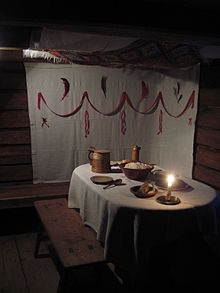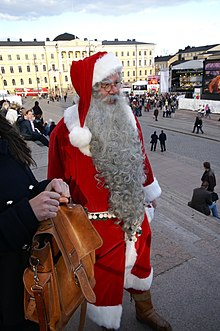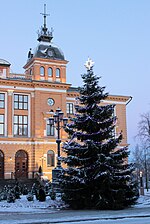This article has multiple issues. Please help
improve it or discuss these issues on the
talk page. (
Learn how and when to remove these template messages)
|

Christmas in Finland ( Finnish: joulu; Swedish: jul) begins, as is commonplace on public holidays in Finland, on Christmas Eve ( Finnish: jouluaatto; Swedish: julafton). [1] Especially the evening of Christmas Eve has become the most important day of the Christmas period, and is nowadays a paid holiday in most workplaces. [2] Unlike on other public holidays, public transportation stops almost completely on the afternoon of Christmas Eve [3] in Finland. The Christmas period ends on Epiphany ( Finnish: loppiainen; Swedish: trettondedagen). [4]
History
In the Finnish tradition, the Christmas period has usually been considered to start on Tuomas’s nameday on December 21 and to continue until St. Knut's Day on January 13. This is reflected in several rhymes and jingles, such as Hyvä Tuomas joulun tuopi, paha Nuutti pois sen viepi (“Good Tuomas the bringer, bad Nuutti the taker of Christmas”). Prior to 1774, Finland also celebrated a third Christmas Day, the day of apostle John the Evangelist on December 27, and a fourth Christmas Day, Massacre of the Innocents on December 28. [5] However, King Gustav III of Sweden cut them down to two, because the nobility and bourgeoisie believed that long holidays made the workers too lazy. [6] The third and fourth Christmas Day have also been called little holidays or midweek holidays. [7] The Finnish Orthodox Church spends Christmas at the same time as the Western Christianity. [8]

The Finnish Christmas has acquired some characteristics from the harvest festival kekri, that used to take place around the old All Saints' Day. In Sweden, Estonia and Finland, joulupukki ( Christmas goat) was a man who dressed as a fertility rite character, a goat. He put goat horns on his head as in shamanistic tradition to look like a goat. The outfit also included a mask made of birch bark and a sheepskin coat worn inside-out. [9]
Feeding small birds at Christmas is an old tradition and the peasant culture’s ritual that brought good luck to farming. The purpose of the barley or oat sheaf was to keep the birds away from the crop in the summer. The Finnish pagans may have believed that the dead, i.e. soul birds, celebrated the mid-winter holiday with the living. They may have also believed birds to bring good luck to the home. [10] In Sweden, the church was against this tradition, and it was about to disappear in Finland too, until some newspapers and charitable organisations revived it.
Some traditional Christmas decorations are himmeli (a hanging decoration made of straw) and Yule Goat. [11] [12] Decorations made of straw have their source in kekri, the harvest festival. [13] The first Christmas trees came to Finland in the middle of the 1800s. [14]
Early-morning Christmas church on Christmas Day morning is part of the Protestant tradition. The Christmas gospel is heard and Luther’s hymn 21 Enkeli taivaan (Vom Himmel hoch, da komm ich her) is sung. Previously the Lutheran church was very strict about attending the Christmas church. If you did not attend, you were reprimanded publicly in the annual catechetical meeting. Reading the Christmas gospel before the meal became common at the end of the 1800s as a consequence of the Christian revival.
Having a sauna at Christmas is an old tradition. People washed in the Christmas sauna before the festivities, and food and drink gifts were left there for the elf. People in wealthy families started giving each other presents at the beginning of the 1800s. [15] Christmas calendars arrived in Finland after the second world war. [16]
The tradition to visit cemeteries to light candles on family graves was started in the 1900s. It became a common practice at the graves of fallen soldiers after the Winter War and soon at other graves too. The Kekri tradition of leaving presents for the dead was moved to Christmas. Nowadays candles may be lighted as a common experience to honor the dead. [17]
Eating abundantly at the Christmas meal comes from the ancient Finns and relates to the agricultural year cycle and the festival of light celebrated around the winter solstice. At a time when food was grown at home, gluttony and eating meat at Christmas was a rare luxury. Lutefisk and porridge are some of the oldest Christmas foods. Barley was replaced by rice in the 1800s. Casseroles, prune soup and gingerbread biscuits were adopted from the upper classes in the 1800s and 1900s. The Christmas ham replaced the kekri lamb, and in the 1940s it was challenged by the wild turkey.
Posti Group has been publishing Christmas stamps since 1973. [18]
Christmas has traditionally been a family celebration, but in the 2000s it has become common to spend Christmas alone. [19]
Celebrating Christmas

The usual Christmas decorations are spruce twigs, Christmas tree, Christmas wreaths, straw goats, himmelis, apples, candles, Christmas tablecloths, Christmas flowers, outdoor torches, ice lanterns and sheafs. [20]
To preserve nature, some people choose a tree in the garden or nearby forest to decorate for the birds, instead of buying a Christmas tree. The tree is decorated with fat balls. [21] Before giving out the presents, some may light candles for the dead. It is commonplace to go in the sauna at Christmas. [22]
The Finnish Christmas meal, Joulupöytä (literally “Yule Table”), normally features different casseroles made usually of carrot, swede ( lanttulaatikko) or potato ( sweetened potato casserole) and various fish, such as cold smoked salmon, gravlax and Coregonus lavaretus ( graavisiika). On Christmas Eve people usually eat rice porridge. [15]
See also

- Christmas Eve
- Finnish Yule Table
- Joulupukki (Father Christmas)
- Pikkujoulu (Little Christmas)
- Star singers
- Tuomaan Markkinat
Sources
- Aurejärvi-Karjalainen, Anneli: Perheen omat juhlat: Siviiliseremoniat häistä hautajaisiin. Porvoo Helsinki Juva: WSOY, 1999. ISBN 951-0-23761-2.
- Vento, Urpo: Joulu, vuoden suurin juhla. Teoksessa Juhlakirja: Suomalaiset merkkipäivät, s. 196–202. Toimittanut Urpo Vento. Kalevalaseuran vuosikirja 59. Helsinki: Suomalaisen kirjallisuuden seura, 1979. ISBN 951-717-178-1.
References
- ^ Aalto, Satu (toim.) (1999). Suuri perinnekirja: Suomalaista juhlaperinnettä ennen ja nyt. Hämeenlinna: Karisto. p. 19. ISBN 951-23-3963-3.
- ^ Helsingin yliopisto (2009). Almanakka vuodeksi 2010 jälkeen Vapahtajamme Kristuksen syntymän. Ajasto. p. 4 (luettelo Suomalaisen kalenterin juhlapäivät) ja 28 (joulukuun aukeama, 24.12. merkitty arkipäiväksi). ISSN 1239-1654.
- ^ Hartikainen, Erkki. "Joulu ja talvipäivän seisaus". Peruskoulun elämänkatsomustieto 4. Archived from the original on 30 September 2007. Retrieved 24 December 2010. (linkin sisältö lienee muuttunut)
- ^ Iso tietosanakirja. 5, Ihminen–Kansallisfilosofia. Helsinki: Otava. 1933.
- ^ Oja, Heikki (1999). Aikakirja. Helsinki: Otava. pp. 166–167. ISBN 951-1-16334-5.
- ^ Harjumaa, Marika: What a miracle Christmas plum ?. Evening messages plus, 2009, no. 23.12.2009, p. 7.
- ^ Vilkuna, Kustaa (2007). Vuotuinen ajantieto: Vanhoista merkkipäivistä sekä kansanomaisesta talous- ja sääkalenterista enteineen. 24. painos (1. laitos 1950). Helsingissä: Otava. p. 345−350. ISBN 978-951-1-12544-0.
- ^ "The Coptic Calendar" (PDF). Copticheritage.org. Archived from the original (PDF) on 2006-09-28. Retrieved 16 April 2010.
- ^ Karjalainen, Sirpa (1994). Juhlan aika: Suomalaisia vuotuisperinteitä. Porvoo Helsinki Juva: WSOY. ISBN 951-0-22920-2.
- ^ Lempiäinen 2008, s. 96.
- ^ "Himmeli". Tulkoon joulu. Kirjastovirma. Retrieved 24 May 2009.[ dead link]
- ^ "Joulun esine – olkipukki". Satakunnan museo. December 2004. Archived from the original on 7 November 2007. Retrieved 6 December 2009.
- ^ Aurejärvi-Karjalainen 1999, s. 192.
- ^ Vuorio, Jukka (25 December 2016). ""Mässäily on aina ollut joulun ydin"". Helsingin Sanomat. Retrieved 27 December 2016.
- ^ a b Aurejärvi-Karjalainen 1999, s. 193.
- ^ Aurejärvi-Karjalainen 1999, s. 191.
- ^ Aurejärvi-Karjalainen 1999, s. 190.
- ^ "Lainattavat näyttelyt". Postimuseo. Retrieved 25 December 2016.
- ^ Malmberg, Katarina (24 December 2016). "Joulusta voi nauttia myös yksin – yksinäisyys voi antaa hengähdystauon tai intoa tehdä uusia asioita". Helsingin Sanomat. Retrieved 27 December 2016.
- ^ "Yule (talvipäivänseisaus)". Thuleian tupa. Retrieved 24 December 2010.
- ^ Hallivuori, Laura (27 November 2008). "Viherrä joulusi". Vihreä lanka. Retrieved 13 February 2010.
- ^ "Rakas, tuttu ja tunnelmallinen suomalainen joulu – jouluperinteet". Plaza.fi. 14 November 2007. Archived from the original on 8 January 2009. Retrieved 6 December 2009.